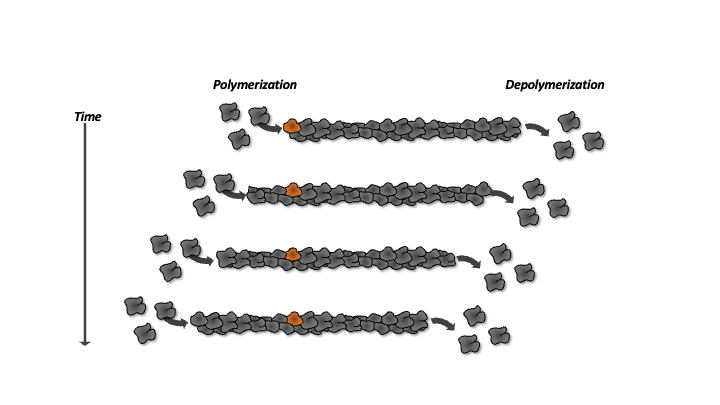Biophysics to understand the emergence of complex molecular functions

Filament grows at one end and shortens at exactly the same speed at the other. This unidirectional movement is similar to a treadmill, a well-known molecular motor mechanism. Credit image : Amine Mehidi, UNIGE.
Towards a better understanding of evolutionary theory
While evolutionary theory allows us to understand how existing characteristics are naturally selected by environmental factors, the way in which several new attributes required for complex biological mechanisms emerge jointly during the course of evolution is limited. The study by Karsten Kruse, full professor in the Department of Biochemistry at the University of Geneva and the National Center of Competence and Research in Chemical Biology (NCCR Chemical Biology), and Zena Hadjivasiliou, currently head of a research team at the Crick Institute, London, and at University College London, published in Physical Review Letters, could lead to a better understanding of evolutionary theory by showing how a complex function can emerge during evolution: the functioning of a molecular motor.
A simulation of chance and a fascinating result
In this article, the researchers consider a fairly simple system: a filament made up of bricks whose size can be altered by adding or removing bricks at either end. The simulation imposes just one constraint: the average size of the filament. The system is free to choose the speed at which bricks are added and removed, and their affinity for the two ends. By imposing only this constraint and letting the system evolve the other parameters, the researchers made a surprising observation: their simulation systematically converges towards the dynamics of a filament that grows at one end and shortens at exactly the same speed at the other. This unidirectional movement is similar to a treadmill, a well-known molecular motor mechanism.
Treadmilling is a type of molecular motor particularly present in bacteria, in which it is involved in distributing DNA evenly over daughter cells. It is also found in actin filaments, one of the proteins making up muscles, for example in the hair cells of the human inner ear.
Prof. Kruse explains, "Until now, how complex functions arise in the course of evolution is poorly understood. This work shows that a simple, static physical selection factor enables the emergence of unidirectional movement". Dr. Hadjivasiliou adds that "these results reveal that the physical constraints imposed on molecular self-assembly determine evolutionary dynamics and can lead to the emergence of complex functions".
Image credit illustration on the welcome page: Adobe Stock / Dr_Microbe
November 15, 2023Lastest news
